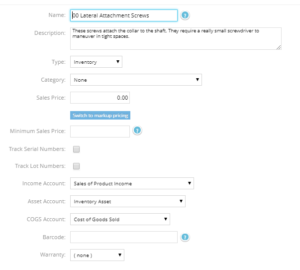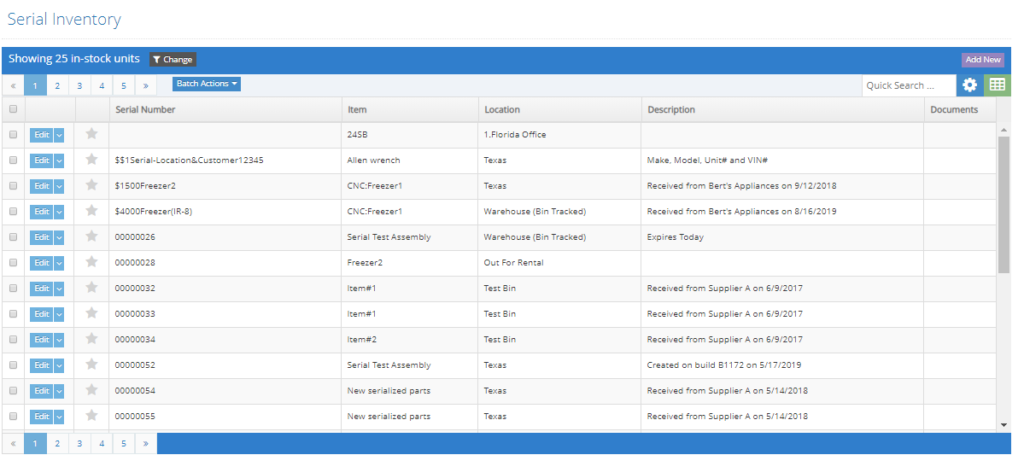Perpetual Inventory System
There are different methods for tracking inventory and the tool you use to do it will depend on your preferred method.
Perpetual vs. Periodic
In a perpetual inventory system, cost of goods sold is always recorded to maintain an up-to-date inventory count. A periodic inventory system is accurate at the time it is updated. That may be at the end of a month or quarter, depending on what the individual business decides to do. Most businesses today use a perpetual inventory method. Small businesses may be able to get by with a periodic inventory system, but if the goal is to grow, that system could be a hindrance. Traditionally, the biggest barrier to choosing to do so has been the cost, but today with software costs decreasing, a perpetual system is in reach for smaller businesses, too. Luckily for the small business that wants to get bigger, SOS Inventory can do both.
In a periodic inventory system program, when the inventory account is updated to reflect the cost of goods sold, that amount is subtracted from the gross revenue to indicate the company’s gross margin. Counting inventory daily just is not scalable for some businesses; the price they pay is not having an accurate picture of their accounting until the inventory count is updated. Subsequently, the business will not have real-time figures until the inventory update takes place.
| Aspect | Perpetual Inventory System | Periodic Inventory System |
|---|---|---|
| Definition | Continuously updates inventory records with each purchase and sale using technology such as barcodes and RFID. | Manually counts inventory at regular intervals to update records. |
| Accuracy | Provides real-time accuracy and can identify discrepancies immediately. | Prone to human error and may result in inaccurate records. |
| Time Commitment | Requires ongoing monitoring and management. | Requires regular physical inventory counts, which can be time-consuming. |
| Scalability | Can handle larger inventories and more complex operations. | Limited, as the size and complexity of inventory counts can become unmanageable. |
| Inventory Management | Enables businesses to keep accurate records and easily identify inventory levels, reorder points, and trends. | Provides a more general overview of inventory levels and does not offer real-time information. |
What is a Perpetual Inventory System?
 Under a perpetual inventory system, updates are made continuously – every time a product is sold, bought or manufactured. The same goes for returns; the inventory count will be immediately updated upon their arrival. Save for theft or damaged goods, a perpetual inventory count should always reflect the true number. These updates occur not only at the point of sale; the data is sent back to a central database. When a barcode is swiped, the inventory update occurs across the system. There is never a need to close a store to update inventory as can be the case with a periodic inventory system. There are many benefits to having a continuous inventory system, one of which is the availability of accurate numbers any time you need a report.
Under a perpetual inventory system, updates are made continuously – every time a product is sold, bought or manufactured. The same goes for returns; the inventory count will be immediately updated upon their arrival. Save for theft or damaged goods, a perpetual inventory count should always reflect the true number. These updates occur not only at the point of sale; the data is sent back to a central database. When a barcode is swiped, the inventory update occurs across the system. There is never a need to close a store to update inventory as can be the case with a periodic inventory system. There are many benefits to having a continuous inventory system, one of which is the availability of accurate numbers any time you need a report.

The greater the sales volume and more locations involved, the more pressing the need for a perpetual inventory system. When products move quickly, a business needs the ability to readily determine how much more to order to replace it. Big ticket items, such as cars or fine art, do not move as quickly hence these businesses may not have an issue with a periodic inventory system.
Having a perpetual inventory system program is especially helpful in cases where a business has products at many different locations. The point of sale transaction will update the central inventory count so the business owner can always see how many of each product is available, where it is located, and how much income it generated.
If a business owner’s goal is to attract investors or sell his business at some point, he will need the most accurate picture of his business at any time. Accurate, transparent books are auditable, clear to present and easily to interpret. And that is when a business might consider making the move to SOS Inventory.
When You Should Use Perpetual Inventory System Accounting
Perpetual inventory systems are beneficial for anyone who wants to understand profitability and margins. While any business can benefit from perpetual inventory management, larger businesses that have many products will get the most out of this form of accounting. Companies that are looking to scale over time should also look into this system and what it provides.
Even though periodic inventory systems have their advantages, perpetual inventory systems are almost certainly the future for companies that sell or manufacture products. These systems are becoming more affordable, which makes them more accessible for smaller businesses. Once you implement this system, every product will be paired with a tracking code, which means that you can always find a product regardless of where it’s stored.
Whenever your business purchases additional inventory or makes a sale, the software will record these changes directly in a sales revenue account. By taking this approach, accounting records will accurately display how balances are affected. When you want to record transactions via a perpetual system, you will need to know the purchase price, sale price, and any accounts that were affected.
A product’s sale price is what it’s sold for to the customer. As for the purchase price, this takes all product costs into account, which include receiving, shipping, and storage costs. A standard entry in a perpetual system will show the specific account that the software debited during the transaction while also displaying the account that was credited.
 At SOS Inventory, we make it easy to manage your inventory, giving you visibility and transparency. SOS Inventory is affordable starting at only $64.95/month for 2 users. To make the decision even easier, we offer a no risk, free trial for the first 14 days. We have a reputation of offering stellar customer support, why not run a trial and see for yourselves! You will wonder how you ever managed your operations without SOS Inventory. SOS can be implemented as quickly as 3 to 6 weeks. It is so much easier to implement than larger, bloated systems that can take a full year to implement, causing chaos in your business in the meantime. SOS Inventory is the affordable option for SMEs who want accurate inventory and reporting at any time.
At SOS Inventory, we make it easy to manage your inventory, giving you visibility and transparency. SOS Inventory is affordable starting at only $64.95/month for 2 users. To make the decision even easier, we offer a no risk, free trial for the first 14 days. We have a reputation of offering stellar customer support, why not run a trial and see for yourselves! You will wonder how you ever managed your operations without SOS Inventory. SOS can be implemented as quickly as 3 to 6 weeks. It is so much easier to implement than larger, bloated systems that can take a full year to implement, causing chaos in your business in the meantime. SOS Inventory is the affordable option for SMEs who want accurate inventory and reporting at any time.

Q: What is the difference between LIFO periodic and perpetual?
A: Just as described above, the periodic versus perpetual methods differ by how often the inventory count is updated. LIFO, or last in first out, refers to the inventory accounting method applied to either process wherein the last item received is sold first. Most businesses choose to use the opposite accounting method, namely FIFO, first in first out. Your accountant can recommend the best model to fit your business.
Q: What advantages does a perpetual inventory system have over periodic inventory system?
A: A perpetual inventory system always maintains the same data across the central system so costs and physical inventory counts are identical for every person accessing the information. Because the periodic system is updated from time to time versus real time, one can only be assured the data is accurate after taking a physical count.
Q: What is perpetual inventory system example?
A: When a business experiences frequent turnover of product, maintaining accurate numbers becomes an impossible task with a periodic system. A grocery store, for example, receives fresh food each week and aims to sell it before the expiration date. A small, specialty shop, however, may sell some items infrequently and manage just fine with a periodic system.
Q: What are the disadvantages of using a perpetual inventory system?
A: Because systems are automated, if an item is lost or broken, your software won’t know that. To account for these discrepancies, a physical inventory check from time to time is recommended.
Q: Why would someone choose not to use a perpetual inventory control system?
A: If a business is handling inventory on their desktop spreadsheets, they lack the capabilities to keep inventory in real-time.
Perpetual Inventory Software
 Perpetual inventory software empowers managers to compare information against physical inventory to uncover variances. In doing so, the need for a daily physical inventory count is eliminated as all counts are updated in real-time with every transaction that takes place. The end result is more accurate number and savings on inventory and labor. Should inconsistencies arise, identifying their source is easier to do and rectify.
Perpetual inventory software empowers managers to compare information against physical inventory to uncover variances. In doing so, the need for a daily physical inventory count is eliminated as all counts are updated in real-time with every transaction that takes place. The end result is more accurate number and savings on inventory and labor. Should inconsistencies arise, identifying their source is easier to do and rectify.
Perpetual Inventory Method
By adding your beginning inventory to receipts and then subtracting your shipments, you arrive at your ending inventory. This is the perpetual inventory method, often applied to reduce ghost and lost inventory are significantly reduced.






